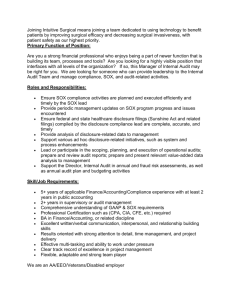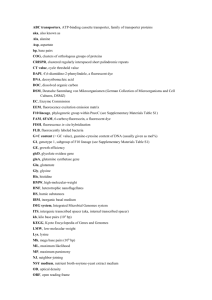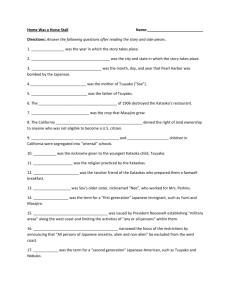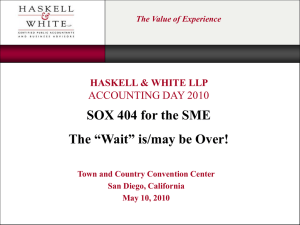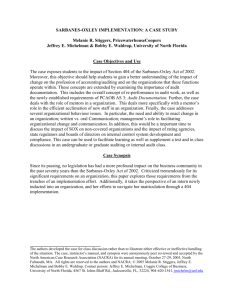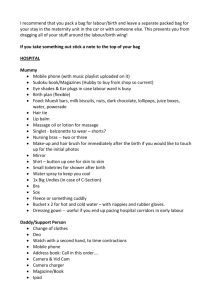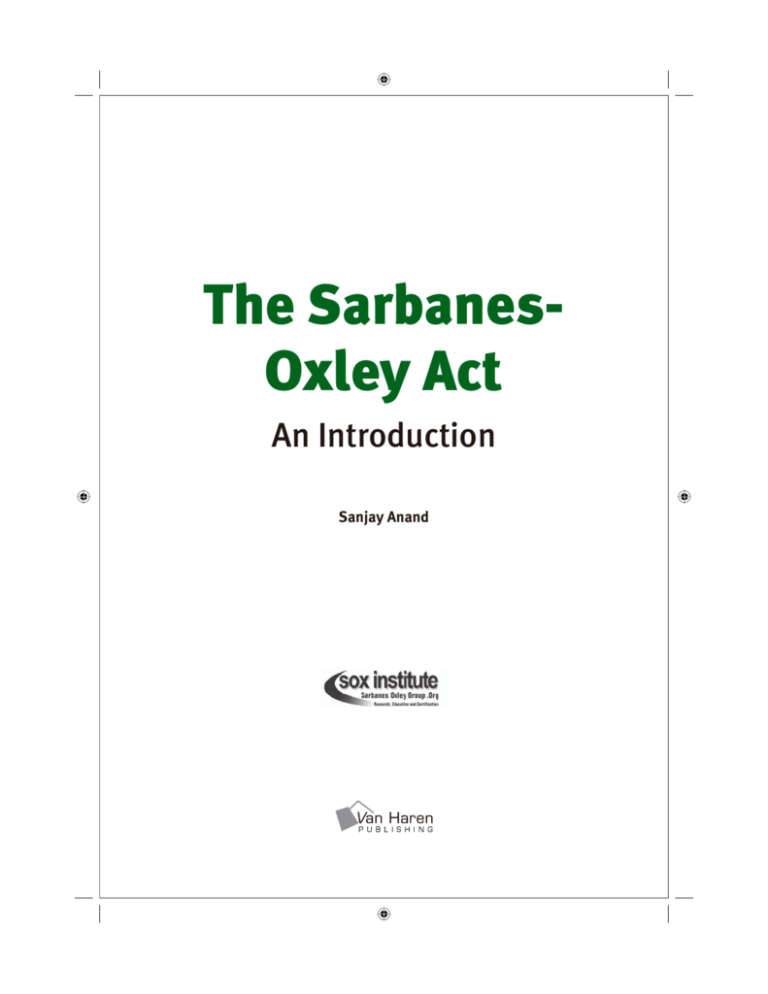
The SarbanesOxley Act
An Introduction
Sanjay Anand
Colophon
Title:
The Sarbanes-Oxley Act: An Introduction
Author:
Sanjay Anand
Editor:
Jayne Wilkinson
Publisher:
Van Haren Publishing, Zaltbommel. www.vanharen.net
Design and layout: CO2 Premedia BV, Amersfoot, NL
ISBN:
978 908753 083 9
Edition:
First edition, first impression, June 2008
©Van Haren Publishing
All rights reserved. No part of this publication may be reproduced in any form by print, photo
print, microfilm or by any other means, without the written permission of the publisher.
Although this publication has been composed with much care, neither author, nor editor, nor
publisher can accept liability for damage caused by possible errors and/or incompleteness in
this publication.
The publisher will endeavour to correct any errors in subsequent editions when they are
notified.
ITIL ® is a Registered Trade Mark, and a Registered Community Trade Mark of the Office of
Government Commerce, and is Registered in the US Patent and Trademark Office.
CoBiT® is a registered trademark of the Information Systems Audit and Control Association
(ISACA)/IT Governance Institute (ITGI).
The Sarbanes-Oxley Act: An Introduction
An in-depth introduction to the Sarbanes-Oxley (SOX) Act and compliance
issues, this new guide examines SOX-specific process, domains, regulation
and abbreviations, to provide a comprehensive view of the Sarbanes-Oxley
Act and the issues involved in complying with this important US-centred
legislation, which is now being referenced worldwide, and globally adopted.
SOX Institute Series:
This new series on the Sarbanes-Oxley Body of Knowledge (SOXBOk) is
the world’s most comprehensive, authoritative compendia on SarbanesOxley (SOX). Produced in association with the SOX Institute, the leading
provider of Sarbanes-Oxley research, education, certification, advisory
and membership services for GRC (Governance, Risk Management and
Compliance) professionals, the SOXBoK has been created by practitioners
for practitioners. The books in this series cover all of the Titles and
sections of the Sarbanes-Oxley Act (SOA), and provide actionable advice
for implementation using GASP (Generally Accepted SOX Principles).
A must-have for anyone implementing SOX and similar regulations, the
books address all of the disciplines impacted by SOX, including Finance,
Accounting, Audit IT, Ethics, Legal and Risk.
www.vanharen.net
978 908753 083 9
INTRODUCTION:
An Introduction to the Sarbanes-Oxley
Body of Knowledge (SOXBoK) from the
SOX Institute
‘By practitioners for practitioners’
The Sarbanes-Oxley Body of Knowledge (SOXBoK) has been developed by a
select group of volunteers and recruits from the growing, active membership
of the SOX Institute. Every member of the team is an active practitioner in at
least one area of Sarbanes-Oxley compliance efforts within public companies.
The SOXBoK was completed in three, distinct phases:
• Phase I of the project, involved forming several small teams to complete
initial scope planning, research and content development, driven by team
leads with expertise in specific Knowledge Areas to include:
− Finance and Accounting
− Information Technology
− Legal and Ethical Compliance
− Internal and External Audit
• Phase II of the project, involved a single, smaller team with crossfunctional representation focused on knowledge sharing and analysis of
the content, focusing on fact checking the content submitted by the Phase
I activities.
• Phase III of the project, involved the same team as Phase II, with members
now working directly with the SOX Institute Board of Directors to finetune the content, obtain and incorporate public commentary, and coordinate with the publisher to edit the book into its final format.
8
The Sarbanes-Oxley Act: An Introduction
The Sarbanes-Oxley Act of 2002 (SOA or SOX Act) had far-reaching
implications for the operations of public companies, which were greater than
any other legislation to date. Large publicly traded companies are required by
law to comply with the guidelines of the SOX Act; however, more and more
mid-size and non-public companies are making the choice to comply with
the SOX Act to instill greater stakeholder confidence in their operations and
financials.
The Sarbanes-Oxley Act: An Introduction strives to align itself with the SOX
Institute’s objectives: The SOX Institute was created to enable individuals and
enterprises to:
• freely share and exchange SOX-related information, expertise and
experiences
• enable members to understand and appreciate the implications of SOX on
their industry, their companies, their careers and their jobs
• establish and adhere to the industry-wide standards of SOX competence
• take SOX compliance to a whole new level, both in the US, and around
the world
The SOX Institute (now known as the Governance, Risk, Compliance (GRC)
Institute) has, since its inception in 2003, organized over 100 training
sessions, published four books on the Sarbanes-Oxley (SOX) Act, and trained
more than 2,000 professionals and executives in SOX Act compliance, across
the US, Canada, Europe, the Indian sub-continent and Asia.
The SOXBoK is intended to be a reference document for practitioners who
are responsible for implementing the Sarbanes–Oxley Act of 2002 (‘SOX’)
within their organizations. The content of the guide is written in a clear
style appropriate for any level, from absolute beginners to those who want
to become professionals in their audit-related fields. The SOXBoK has been
developed by industry practitioners to:
• establish a consensus mechanism for delineating the knowledge and skills
required to be a professional
• characterize standard practices of the profession
• guide the development of quality knowledge and skill competency
assessment
• provide a background for curriculum development efforts throughout
academia
Introduction
9
The SOXBok includes each title and section of the SOX Act in its entirety. All
11 Titles and 66 sections of the SOA of 2002 were analyzed and documented
in the SOXBoK. Each Title and section of the SOX Act is summarized
and categorized for easy reference and comprehension, and industry best
practices are discussed from the practitioner’s perspective.
While developing and finalizing this Introduction, the team considered the
following content and editorial assertions:
• Completeness – all elements in the SOX Act are addressed
• Accuracy – the right level of detail and instruction
• Actionable – how would you implement this section?
• Single Source – direct references within the SOX Act (eg Securities
Exchange Act of 1934) are explained within the synopsis
• Consistency – flow, style, presentation
• Clarity – fully explained, clear, concise, readable
• Relevance – relevant to the section discussed and relevant to the audience
SOX-Specific Terminology and Abbreviations
This Introduction uses terminology that is particular to the audit, legal or
accounting professions. Terms and acronyms that are consistently used
throughout this publication are defined below. Additional terminology is
defined in the Glossary:
• GASP – Generally Accepted SOX Principle is a practice that is the best
response to a given section of the SOX Act
• Issuer – public company, which must issue financial reports according to
Securities and Exchange Commission (SEC) regulations and/or the SOX
Act
• PCAOB – Public Company Accounting Oversight Board
• SEC – Securities and Exchange Commission
• SOX – Interpretation of the Sarbanes-Oxley Act of 2002
• Audit Partner – accountant with primary responsibility for attesting to
the adequacy of the issuer’s compliance with the regulations in the SOA
10
The Sarbanes-Oxley Act: An Introduction
SOX Processes
This section identifies key processes, domains, and Knowledge Areas
associated with each SOX Title. SOX processes are the steps needed to
comply with SOX requirements within multiple business functions, impacted
by each section within identified domains, including:
• Regulations for Others – SOX requirements that apply to government
agencies, independent accounting firms, or other groups that are not part
of the issuing company; detailed knowledge of these regulations is not
integral to Issuer complian ce with the SOX Act, but practitioners should
be aware of these sections and Titles to build their awareness of the whole
process
• Planning – setting up committees, preliminary preparation work,
building the underlying structure for adequately responding to SOX
requirements
• Risk Analysis – identifying where the financial risks lie, which ultimately
determines which process controls will need to be evaluated and attested
to by executive management
• Control Assessment – identifying which controls/processes are in place
and determining whether they address the financial risks
• Control Testing – systematically selecting samples from each control/
process, and evaluating whether the process and practice is effective
• Co-ordinating with Auditors – co-ordinating with internal audit
resources to plan, assess and report on internal controls; working
effectively with external audit to expedite independent testing and
evaluation of management’s testing
• Control Deficiencies and Remediation – once a control has been deemed
ineffective, this process identifies the root cause(s) of the deficiency and
how to fix it; then re-testing of controls is performed to clear associated
audit comments
• Reporting and Communication – specifies which reports are required,
what formats should be used, how frequently reports should be prepared
and submitted, and by whom
• Evaluation and Control Enhancement – determining which effective
controls/processes are not operating as well as they could be, and then
making improvements
Introduction
11
• Sustaining – building effective controls/processes into your company’s
daily routine for strong, reliable reporting capabilities
• Audit Compliance and Enforcement – what to do if serious material
findings result in a Federal investigation or court case
SOX Domains
Domains, within the context of SOX compliance, are disciplinary overlays
that aid in the understanding and implementation of the intent of the SOX
Act. The objective is to ensure that auditors remain independent; corporations
and auditors are accountable to the public for the numbers they publish; an
independent body governs financial reporting processes; sufficient measures
are in place to deter fraudulent activity; financial activities are transparent
enough to allow fraud detection to occur; and if fraud is detected, somebody
is held responsible for it. Domains help answer the question, ‘what gets
accomplished or achieved as a result of this section of the SOX Act?’
12
The Sarbanes-Oxley Act: An Introduction
Summary of Domains by Section
Indexed By Topic
Independence: an environment where auditing bodies are not affiliated with or controlled by an
issuer, and therefore are more likely to issue an objective opinion
Section 103 Independence standards and rules
Sections 104, 201, Registered public accounting firms:
203, 204 • PCAOB periodically inspects and assesses work
• Prohibited from performing both auditing and other services that may
present a conflict of interest
• Lead audit partner and reviewing partner’s primary responsibility for an
issuer’s audit limited to 5 years
• Must submit regular reports to the company’s audit committee
Sections 202, 205, Issuer audit committee:
301 • Independent from the company; approves and oversees all registered
public accounting firm work
• Comprised of members of Board of Directors
• Independence
Section 206 Limitations on former registered accounting firm or its employee acting as
director/officer for issuer
Section 103 Independence standards and rules
Section 104 PCAOB periodically inspects and assesses registered public accounting firm
work
Section 201 Registered public accounting firms prohibited from performing both auditing
and other services that may present a conflict of interest
Section 202 Audit committee, independent from the company, approves and oversees all
registered public accounting firm work
Section 203 Lead audit partner and reviewing partner’s primary responsibility for an
issuer’s audit limited to 5 years
Section 204 All registered public accounting firms must submit regular reports to the
company’s audit committee
Section 205 Audit committee comprised of members of Board of Directors
Section 206 Limitations on former registered accounting firm or its employee acting as
director/officer for issuer
Section 301 Audit committee independence
Introduction
13
Accountability: answering to a higher level or regulating body
Section 102
Public accounting firms must register with, and pay annual fees to, PCAOB
Section 302
Management responsibility for design, implementation, evaluation and
reporting of disclosure controls to SEC
Section 401
SEC requirements for filing financial statements
Section 403
Stock transactions must be filed with SEC
Section 404
Issuer must report weaknesses of Internal Control Over Financial Reporting
to registered public accounting firm; registered public accounting firm
must attest to, and report on, assessment of internal controls made by
management to SEC
Section 405
Exemptions from requirements of Sections 401, 402 and 404
Section 406
Failure to adopt a ‘code of ethics’ must be disclosed to SEC
Section 407
Issuers must include a financial expert in their audit committee
Section 501
Registered securities association or national securities exchange must
modify their rules relating to securities analysts findings
Section 906
Directors/officers must certify every periodic report submitted to the SEC, or
else face criminal penalties
Section 1001
CEO is individually accountable and responsible for financial reporting results
Section 1103
During cease-and-desist proceeding, SEC can issue temporary order requiring
the issuer to escrow extraordinary payments
Section 1104
US Sentencing Commission must review and update sentencing guidelines
applicable to securities and accounting fraud and related offences
Governance: the continuous exercise of authority over and the performance of functions for a
political unit
Section 101
PCAOB governance of internal and external auditors
Section 103
PCAOB establishes rules and requirements for auditing
Section 106
PCAOB oversees foreign accounting firms
Section 107
SEC oversees the PCAOB operations
Section 108
Accounting standards acceptable to SEC
Section 109
PCAOB funding and budgeting guidelines
Section 202
Audit committee pre-approval required for all registered public accounting
firm activities
Section 203
SEC requires a mandatory auditor rotation
Section 204
All registered public accounting firms must disclose key company financial
information to the audit committee
Section 205
Audit committee oversees registered public accounting firm
Section 206
SEC limits who can act as director/officer for issuer
Section 207
US Comptroller General to publish a study on mandatory auditor rotation
effectiveness
Section 208
Registered public accounting firm cannot perform audit activities if engaged
in activities prohibited by Securities Exchange Act of 1934
Section 209
Applicability of Title II requirements determined by appropriate state
authorities
Section 307
Escalation process for attorneys reporting deficiencies
14
Section 404
The Sarbanes-Oxley Act: An Introduction
Issuer must report weaknesses of internal control over financial reporting
to registered public accounting firm; registered public accounting firm
must attest to, and report on, assessment of internal controls made by
management to SEC
Section 408
SEC right to review financial statements and disclosures at will
Section 601
Additional funds appropriated to SEC
Section 602
SEC authority to reject or refuse any auditor
Section 603
Prohibition of brokers, dealers, and issuers from participating in penny stock
transactions
Section 604
SEC authority to censure or restrict an associated person or a broker or
dealer from engaging in the business of securities, banking or insurance
Section 701
US General Accounting Office (GOA) must submit a study concerning ‘Public
Accounting Firms-Mandated Study on Consolidation and Competition’
Section 702
SEC must submit a report addressing each of the topics identified for
Commission study in the Sarbanes-Oxley Act
Section 703
SEC must submit a report and study addressing violations by security
professionals
Section 704
SEC must submit a study on enforcement actions
Section 705
Analysis by the US General Accounting Office on role of Investment Banks
with respect to the corporate scandals conducted by Enron and WorldCom
executives
Section 802
Criminal penalties for altering documents in the course of an investigation
Section 804
Statute of limitation for filing a fraud claim
Section 805
US Sentencing Commission to revisit and update the sentences relating to
obstruction of justice and extensive criminal fraud
Section 807
Criminal penalties for defrauding shareholders of publicly traded companies
Section 1104
US Sentencing Commission must review and update sentencing guidelines
applicable to securities and accounting fraud and related offenses
Deterrence: the measurements taken to prevent in appropriate behavior using fear, especially of
punishment
Section 102
Unlawful for an unregistered public accounting firm to issue audit report
Section 104
PCAOB periodically inspects and assesses registered public accounting firm
work
Section 105
Disciplinary action against registered public accounting firms for noncompliance with investigatory proceedings
Section 107
SEC has the authority to remove PCAOB board members who have willfully
violated the SOX Act
Section 108
Establishing accounting standards
Section 303
Employees, officers, etc. are prohibited from influencing the outcome of an
audit
Section 304
If restatement filed for ‘material non-compliance’, directors/officers must
reimburse issuer for certain types of compensation
Section 305
SEC has authority to prohibit an individual from serving as a director/officer
Section 308
Civil penalties and repayment to investors may be required when violations
of the federal securities acts occur involving fraud
Introduction
Section 802
Section 902
Section 903
Section 904
Section 905
15
Criminal penalties for altering documents in the course of an investigation
Increased penalties for criminal fraud offenses
Increased penalties for defrauding shareholders
Increased penalties associated with a conviction
US Sentencing Commission must review sentencing guidelines related to
certain white collar crimes
Section 1102
Penalties for tampering with evidence and/or documents in an official
proceeding
Section 1106
Maximum SEC penalty fine for individuals, corporations, entities is defined
Section 1107
Penalties for retaliation or discrimination against another person providing
information to the SEC
Transparency: the state of openness or being free from pretense or deceit
Section 102
Public accounting firms must submit reports to PCAOB, periodically and upon
request
Section 301
Audit committee oversight of audit activities
Section 306
Guidelines and requirements for insider trading
Section 401
GAAP accounting principles must be used for filing financials
Section 402
Prohibition of personal loans from issuer to directors/officers
Section 403
Issuers must make stock purchase information available to the public
Section 404
Weaknesses in the effectiveness of the internal control over financial
reporting must be reported by management to the registered public
accounting firm
Section 409
Issuers must quickly disclose information about material changes in the
financial conditions or operations to the public
Section 806
Whistleblower program must be established
Section 906
Directors/officers must certify every periodic report submitted to the SEC, or
else face criminal penalties
Responsibility: the moral, legal, or mental obligation for a course of action or producing results
Section 307
Ethical responsibilities of attorneys
Section 401
Issuer is responsible for disclosing complex transactions and pro forma
figures
Section 403
Insiders must file periodic statements with the SEC
Section 406
Issuers must adopt a ‘code of ethics’ for directors/officers
Section 407
Issuers must disclose who is the financial expert of the audit committee to
the SEC, or disclose why they have none
Section 501
Working environment for securities analysts must promote objectivity and
independence
Section 803
Debts incurred as a result of criminal activity against Federal or State security
laws will not be discharged
Section 805
US Sentencing Commission to revisit and update the sentences relating to
obstruction of justice and extensive criminal fraud
Section 806
Whistleblower program must be established and communicated to all
employees
Section 807
Criminal penalties for defrauding shareholders of publicly traded companies
16
The Sarbanes-Oxley Act: An Introduction
Section 906
Section 1001
Section 1105
Directors/officers must certify every periodic report submitted to the SEC, or
else face criminal penalties
CEO is individually accountable and responsible for financial reporting results
SEC authority to prohibit individuals from serving as directors/officers during
cease-and-desist proceeding
Knowledge Areas identify the corporate resource or department that is
most responsible for compliance with, or that implement, a particular SOX
regulation. Areas of responsibility addressed in this Introduction include:
• Accounting and Finance (A and F) – Although the entire department(s)
might participate in the design and implementation of specific controls,
the Chief Financial Officer (CFO) or equivalent director or officer of the
issuing company, would be ultimately held responsible for all actions
taken by this Knowledge Area.
• Information Technology (IT) – The Chief Information Officer (CIO)
or equivalent, and his or her staff are responsible for insuring the
technological and systems security for the company.
• Law, Ethics and Compliance (LEC) – Activities undertaken by this
Knowledge Area may actually bridge several different departments in
the practitioner’s company, involving legal counsel, human resources and
compliance officers.
• Internal/External Audit (IEA) – Internal audit refers to those functional
areas which actually carry out audit testing on behalf of management, or
a department which oversees the issuer’s self-audit activities. External
audit is defined as the registered public accounting firm that is hired to
issue an audit conclusion. These Knowledge Areas were combined for the
purposes of this Introduction, to emphasize the close working relationship
and overlapping responsibilities between the two.
Practitioners Perspective and Regulation Synopsis
This section provides an explanation of the Sarbanes-Oxley Act in terms
meaningful to financial and business professionals faced with meeting
the requirements of SOX. With the goal of being a single source of
high-level SOX information, any references to other legislation, by the
Security Exchange Commission and other government entities, have been
summarized within the synopsis.
Introduction
17
Generally Accepted SOX Principle [GASP]
This section explains the generally accepted SOX practice, and points out
the practices or principles that translate into best practices and help a
company become compliant. Since specific ways to comply with the SOX
Act have not been, and are not likely to be, published by the PCAOB, the
practitioner must discern the best way to attain compliance, according to the
company’s priorities, industry, risk factors and budget. This Introduction
offers information about practices and principles that have helped many
other companies comply with the SOX Act, and provides suggestions for the
practitioner’s consideration.

